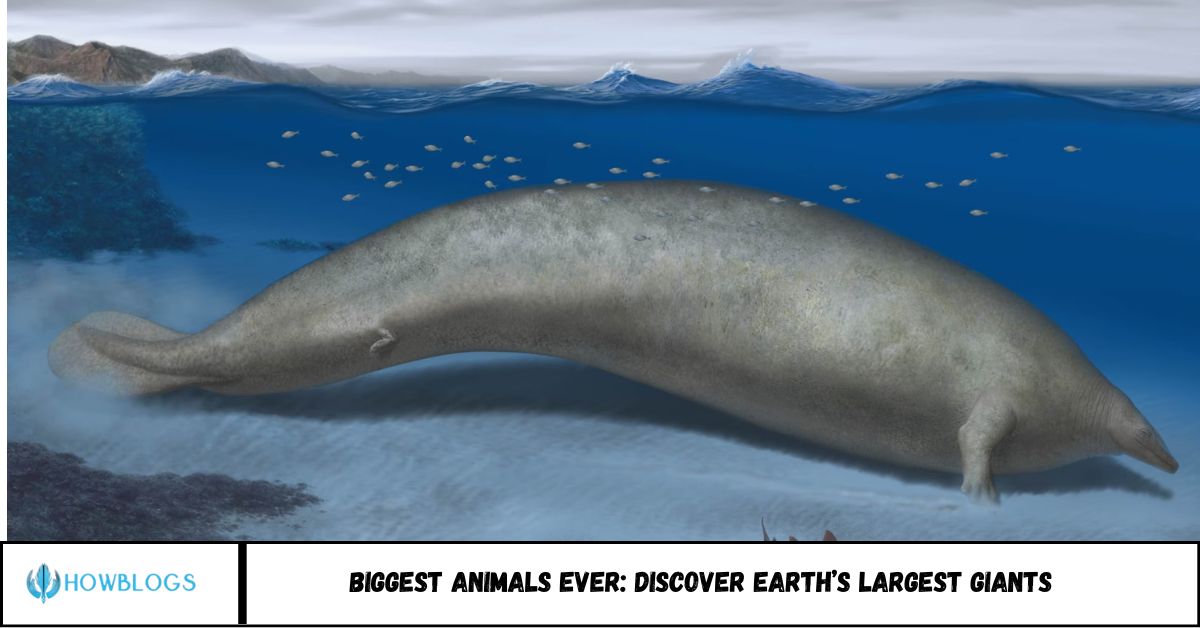Table of Contents
5 of the Biggest Animals to Ever Live on Earth
Have you ever wondered which creatures ruled Earth not just by power, but sheer size?
From dinosaurs that could crush trees with a single step to ocean giants longer than airplanes, the biggest animals to ever live on Earth are truly mind-blowing. Their enormous size is more than just a spectacle—it reveals evolutionary secrets, ecological roles, and the mysteries of prehistoric life.
Scientists have identified around 1.5 million animal species so far, yet estimates suggest nearly nine million may exist in total — meaning countless creatures remain undiscovered. While some animals are barely visible to the naked eye, like the tiny bumblebee bat (just over an inch long and lighter than a penny), others are true giants. Take the colossal squid, for example — a deep-sea monster weighing over 1,000 pounds and stretching more than 45 feet long.
But if you think that’s big, think again. Millions of years ago, Earth was home to animals far larger than anything alive today. From towering dinosaurs to ocean predators the size of buses, prehistoric life was dominated by giants. Let’s explore five of the biggest animals to ever live on Earth — both ancient and modern — and uncover what made them so massive.
1. Blue Whale – The Largest Animal Ever Known
Scientific Name: Balaenoptera musculus
Length: Up to 100 feet
Weight: Over 200 tons
The blue whale is the largest animal to have ever lived, out-sizing even the biggest dinosaurs. Despite their size, these marine mammals feed almost exclusively on tiny krill, consuming up to 4 tons per day.
Key Facts:
- Their hearts are the size of a small car.
- A newborn calf weighs around 3 tons at birth.
- They communicate with low-frequency calls that can be heard hundreds of miles away.
2. Argentinosaurus – The Biggest Dinosaur on Record
Era: Late Cretaceous
Length: Up to 115 feet
Weight: Estimated 100 tons
Argentinosaurus was a titanosaur and likely the longest and heaviest land animal ever discovered. Fossils found in Argentina in the 1990s helped paleontologists estimate its massive size.
Key Facts:
- It likely grew fast, reaching full size in 20-40 years.
- Its long neck helped it access high vegetation.
3. Megalodon – The Largest Prehistoric Shark
Scientific Name: Otodus megalodon
Length: Up to 60 feet
Teeth Size: Up to 7 inches long
Megalodon was the ocean’s apex predator for over 20 million years. Its bite force is estimated at over 40,000 pounds per square inch, making it the most powerful biter in animal history.
Key Facts:
- It went extinct around 3.6 million years ago.
- Preyed on whales, dolphins, and large fish.
4. Spinosaurus – The Largest Carnivorous Dinosaur
Era: Cretaceous Period
Length: Up to 50-59 feet
Weight: 7–20 tons
Spinosaurus might have been even bigger than Tyrannosaurus rex. What makes it unique is its semi-aquatic lifestyle, making it the only known swimming dinosaur.
Key Facts:
- It had a distinctive sail-like structure on its back.
- Likely hunted in rivers and lakes, eating fish and small dinosaurs.
5. African Elephant – The Largest Land Animal Today
Scientific Name: Loxodonta africana
Height: Up to 13 feet at the shoulder
Weight: Up to 14 tons
The African bush elephant is the largest living land mammal. Though dwarfed by prehistoric giants, it plays a vital role in modern ecosystems as a keystone species.
Key Facts:
- Uses its trunk for feeding, drinking, and communication.
- Lives up to 70 years in the wild.
Why Were Some Prehistoric Animals So Big?
Key Factors Behind Gigantic Size:
- Higher oxygen levels in prehistoric atmospheres
- Fewer predators or new ecological niches
- Abundant food sources, especially in oceans and lush prehistoric forests
Larger size often offered evolutionary advantages such as deterring predators, reaching high food sources, or regulating body temperature in different climates.
Modern Giants vs Prehistoric Behemoths
While today’s animals are massive, prehistoric ones often exceeded them in both scale and specialization. However, climate change, human activity, and evolutionary shifts have led to smaller species in many modern ecosystems.
FAQs
1. What is the largest animal alive today?
The blue whale, reaching up to 100 feet and 200+ tons.
2. Were dinosaurs bigger than whales?
Most weren’t. Only a few like Argentinosaurus came close or matched blue whale size in weight.
3. Could Megalodon still exist?
No scientific evidence supports this. It likely went extinct 3.6 million years ago.
4. What’s the biggest land predator ever?
Spinosaurus is believed to be the largest carnivorous land dinosaur.
5. How do elephants compare in size?
Elephants are the largest land animals today but are much smaller than many prehistoric creatures.
6. Why aren’t animals that big anymore?
Environmental changes, lower oxygen, and increased human pressures have reduced the average size of species
Conclusion
From the blue whale’s unmatched mass to the towering Argentinosaurus, the biggest animals to ever live on Earth reveal not only the limits of life but also its adaptability and awe-inspiring potential. Whether prehistoric or present, these giants shaped ecosystems and challenged scientists to understand nature’s extremes.

